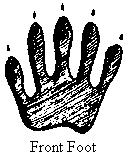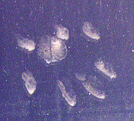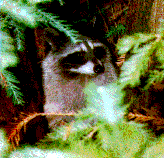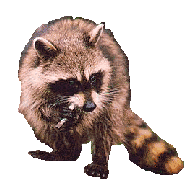![]() Raccoons
Raccoons ![]()



Raccoon Tracks


![]() Natural History of Raccoons
Natural History of Raccoons ![]()
†

Raccoons are familiar animals with masked faces and ringed tails. They have five toes on both the front and hind feet. Their long, dextrous fingers enable them to open latches, untie knots, turn doorknobs, and open jars. Their prints look like tiny human baby handprints and footprints.
They are primarily nocturnal and thrive in many cities as well as wilderness areas. In fact, the densest population of raccoons in New York is in New York City. They are very intelligent and adaptable animals.
They are omnivorous and eat a variety of foods, including frogs, fish, amphibians, shellfish, insects, birds, eggs, mice, carrion, berries, nuts, vegetation, salamanders, insects, berries, corn, cat food, and human garbage.
Their tracks are commonly found near water. It is widely believed that raccoons always "wash" their food. This is not true. They exhibit a behavior called "dabbling" in which they dunk their food in water. This helps enhance their sense of touch and helps them find food underwater by feeling with their sensitive fingers. It also enables them to sort out items that are not edible.
During cold weather, raccoons will sleep for several days, but do not hibernate.
Raccoon scat is tubular and blunt on the ends. Scat may contain parasites that can get into human lungs, so handling it is not advisable.
Three to six young are born in a hollow tree den in April or May. Their eyes open at three weeks. They remain in the den for two months. Young stay with the mother until the following spring.
Raccoons are well known for their curiosity and mischievousness.


![]() Personal Notes on Raccoons
Personal Notes on Raccoons ![]()
I have tracked many raccoons in different environments. They seem to be found almost everywhere Iíve lived, from the desert to the northern California redwood forests. The raccoon is one of my favorite animals.

I have had the opportunity to see them up close, feed them, and even touch a baby raccoon. They are intelligent animals and learn quickly how to get food from gullible humans such as myself. I lived near one family of raccoons who learned to come by my place just after dark for a handout. When I wasnít waiting for them, they would scratch at the door and bang things around outside to get my attention. The following summer, a new raccoon family showed up. They must have been the children of one of the first raccoons because they knew how to get my attention when they wanted food. These were the raccoons who let me touch them. Maybe, after two years of getting handouts from me, they decided to trust me enough to let me get that close.
 ††
†† 
As I stated earlier, I have found raccoon tracks in numerous places. Two of the most unlikely places were the backyard of my home in Whittier, California, and in the riverbed of the Los Angeles River in downtown Los Angeles. Both locations were far from the wilderness areas we usually expect to see these animals in.

I was a young naturalist when I found the prints in Whittier. The raccoon had climbed over a cinderblock wall to get into our backyard. It left several good prints in the soft garden soil. It then went over to the plastic swimming pool cover, which was full of water because it was winter. In the dirt that had accumulated under the water on top of the pool cover, I found the trail of the raccoon. All five toes were clear. The animal had walked around, curiously investigating this new body of water. Perhaps it took a drink before it climbed back over the wall and went on its way. I had a hard time convincing people that those really were raccoon tracks. They couldnít believe that such animals were found in the suburbs. They, like most of us, believe that animals live in the wilderness, that the city is too sterile for animals to live there. (As a side note, no one believed me when I saw a coyote run down the street in front of the house either. Neither did they believe that there were opossums climbing around on the telephone lines outside.)
But, the animals are there. If you know what their tracks look like and learn a little bit about their habits, you may be able to find them near your home too. In the bed of the Los Angeles River, with a busy freeway overpass humming with traffic above, train tracks along both banks, and cars and people everywhere, I found the tracks of a raccoon. The trail led to a culvert, which I assumed was the animalís home. There were other raccoon tracks as well. These animals were living surrounded by humanity and civilization, yet their existence was secret. Why? Because most of us donít know how to recognize the signs of their presence. Hopefully, this web page will help you learn how to recognize those signs.
Find raccoon posters, greeting cards, t-shirts, hats, and more in my new store.
|
Now available: "Animals Don't Cover
Their Tracks - An Introduction to Animal Tracking" on CD! (Version 3.0)
New drawings, more species, more photos, more extensive sections on tracking
humans, more detailed directions for plaster casting, mystery tracks section,
tracking stories section, and more. The CD features over 100 species, including
special bonus sections with the tracks of some African and Australian
animals. A large section on tracking lost people for search and rescue is
included, with over four pages of photos showing the details of tracks and
signs people leave. Easy to use format. This web site is limited
by bandwidth, but the CD-ROM is not. The CD is available in my online store at:
www.dirt-time.com
Works with Mac or PC. Happy tracking!!
What else can you find in the nature store? Beartracker's animal tracks coloring book, T-shirts, sweatshirts, journals, book bags, toddler and infant apparel, mouse pads, posters, postcards, coffee mugs, travel mugs, clocks, Frisbees, bumper stickers, hats, stickers, and many more items. All with tracks or paw prints, or nature scenes. Custom products are available. If you don't see the track you want on the product you want, email me and I can probably create it. Proceeds from all sales go to pay the monthly fees for this web site. You can help support this site as well as get great tracking products! Thank you! |
| Find other tracking products: www.zazzle.com/tracker8459* |
| Also visit these fine
stores for more products of interest: NDN Pride shop - For Indian Pride items for all tribes. Custom items available on request. ASL Signs of Love - For anyone who uses or is learning ASL, American Sign Language. Custom name items and more are available here. Sales from all stores give commissions to Beartracker's Animal Tracks Den, which helps keep this site online as a free service. We are celebrating ten years online this year! |




Got a raccoon story? E-mail me and tell me about it.
†
Copyright © 1997-2007. Text and drawings by Kim A. Cabrera
Raccoon family pictures by Kim A. Cabrera. Other 'coon pics from Webseek.

